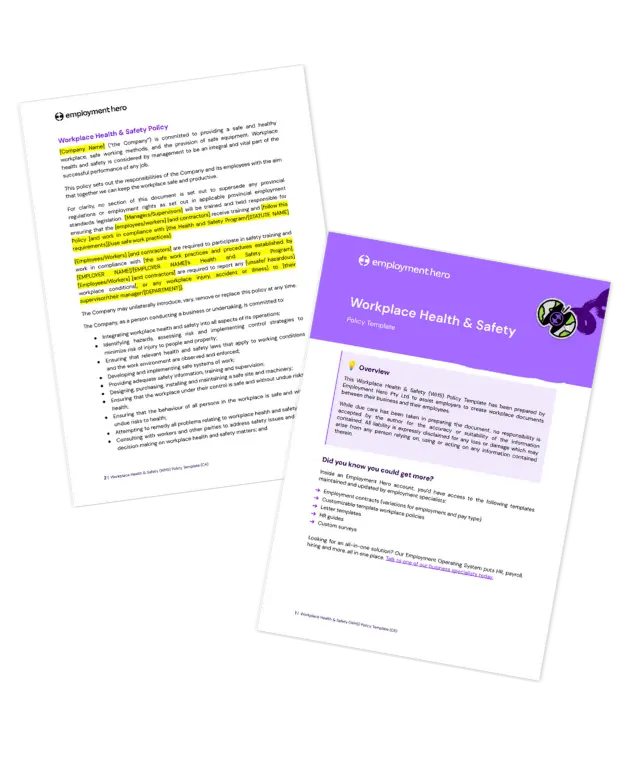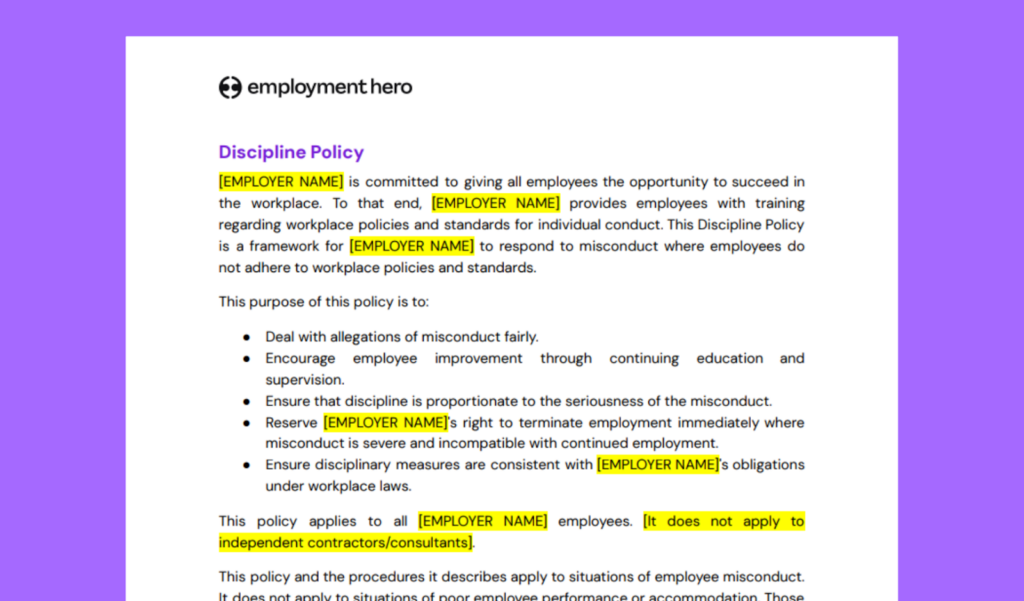Workplace health and safety policy template and guide
Published
Workplace health and safety policy template and guide
Published
A well-crafted Workplace Health and Safety (WHS) policy is essential for any small-to-medium business (SMBs) operating in Canada. It not only demonstrates a company’s commitment to employee wellbeing but is also a legal requirement in many jurisdictions. This comprehensive guide will help you understand the purpose of a WHS policy, its key components and the steps to create one that is effective and compliant with Canadian legislation.
What is in this workplace health and safety policy template?
This policy is a foundational element of a business’s overall health and safety program, which includes all the procedures, rules and training necessary to implement the policy. In many provinces, workplaces with a certain number of employees (as few as six in Ontario) are legally required to have a written policy.
The objectives of this policy are to, as far as reasonably practicable:
- Achieve a safe and incident-free workplace
- Consider WHS in project planning and work activities
- Involve workers and contractors in the decision-making process through regular communication and consultation
- Ensure workers and subcontractors identify and control risks in the workplace
- Monitor and review the elimination or control of potential risks
- Enhance workers’ WHS knowledge through a program of education and training

What is a workplace health and safety policy?
A workplace health and safety policy is a formal document that outlines a company’s commitment to providing a safe and healthy work environment. It serves as a declaration of the employer’s dedication to preventing occupational injuries and illnesses. The policy should be a “living document” that is reviewed and updated regularly to reflect changes in operations, equipment or regulations. It should be signed by a senior executive, such as the owner, president or CEO, to show a top-down commitment to safety.
Why do businesses need a workplace health and safety policy?
There are several compelling reasons for a Canadian business to have a robust WHS policy:
- Legal compliance: In Canada, workplace health and safety is governed by a patchwork of federal, provincial and territorial legislation. Federally regulated workplaces fall under the Canada Labour Code, while most businesses are subject to provincial or territorial acts like Ontario’s Occupational Health and Safety Act. These laws mandate employers to provide a safe working environment and often require a formal WHS policy. Failing to comply can result in significant fines and even imprisonment.
- Defining responsibilities: A policy clearly outlines the duties of all workplace parties (employers, supervisors and employees) in maintaining a safe environment. This “Internal Responsibility System” is a cornerstone of Canadian OHS legislation, where everyone has a role to play in keeping the workplace safe and healthy.
- Risk mitigation: The policy helps proactively identify and control hazards before they can cause injury or illness. It establishes procedures for risk assessment, incident reporting and safety inspections, which are crucial for preventing accidents.
- Fostering a safety culture: By setting clear expectations and encouraging employee participation, a WHS policy fosters a culture of safety where everyone is empowered to contribute to a secure working environment. It reinforces that safety is an integral part of daily operations and not just a formality.
Workplace health and safety policy template
Here’s a preview of the policy template you can download and customize based on your requirements:

How to create an effective workplace health and safety policy
Creating a WHS policy involves a systematic approach and customization. Leveraging the template, make sure you tweak it to suit your industry, workplace and working environment.
Identify workplace-specific hazards
The first step is to conduct a thorough hazard assessment tailored to your business. Don’t just rely on a generic template; consider the specific risks in your environment, from ergonomic issues in an office to fall hazards at a construction site.
Consult and collaborate
Involve employees, supervisors and your Joint Health and Safety Committee or representative in the policy’s development. This ensures the policy is practical and fosters a sense of shared ownership.
Draft the policy
Use a clear and concise tone. Avoid unclear legal jargon and use language that is easily understood by everyone. The provided template is an excellent starting point, which you can customize based on your specific needs. Remember to address all the key components outlined above, including responsibilities, hazard control, training and incident reporting.
Review and approve
Have senior management review and sign the policy to show their commitment. The policy should also be reviewed and updated regularly, at least annually or whenever there are significant changes to the workplace.
Communicate and implement
Once the policy is finalized, ensure it is easily accessible to all employees. This can be done by posting it in a prominent location and/or making it available electronically. Provide comprehensive training to ensure everyone understands their roles and responsibilities.
By following these steps, you can create a WHS policy to protect your business from a legal standpoint but also to create a vital tool for protecting your employees and fostering a safe, productive and healthy workplace.
Download our workplace health and safety policy template
Ready to protect your business and set clear expectations for your team? Download our free, customizable Workplace Health and Safety Policy Template and start crafting a policy that works for your business.
Need more guidance on policy creation? Our HR Advisory team supports SMBs with compliance checks, expert workplace consulting and with an extensive resource library in our platform. Talk to our business specialists to find out more.
The information in this template is current as at 1 September 2025, and has been prepared by Employment Hero Pty Ltd (ABN 11 160 047 709) and its related bodies corporate (Employment Hero). The views expressed in this template are general information only, are provided in good faith to assist employers and their employees, and should not be relied on as professional advice. The Information is based on data supplied by third parties. While such data is believed to be accurate, it has not been independently verified and no warranties are given that it is complete, accurate, up to date or fit for the purpose for which it is required. Employment Hero does not accept responsibility for any inaccuracy in such data and is not liable for any loss or damages arising either directly or indirectly as a result of reliance on, use of or inability to use any information provided in this template. You should undertake your own research and to seek professional advice before making any decisions or relying on the information in this template.
Frequently asked questions about workplace health and safety
In Canada, workplace health and safety is governed by federal, provincial and territorial legislation, varying by jurisdiction and industry. Federally regulated workplaces fall under the Canada Labour Code, while most businesses are subject to provincial or territorial acts like Ontario’s Occupational Health and Safety Act or British Columbia’s Workers Compensation Act. These laws generally mandate employers to provide a safe working environment, identify and control hazards, provide training and establish health and safety committees. Employees also have rights, including the right to know about hazards, participate in safety and refuse unsafe work, alongside responsibilities to comply with safety procedures.
Creating an effective workplace health and safety policy involves a systematic approach: begin by identifying all potential hazards specific to your workplace, then outline clear procedures for risk assessment, control and incident reporting. Ensure the policy is easily accessible and understood by all employees, providing comprehensive training and establishing roles and responsibilities for maintaining a safe environment. Regular reviews and updates are crucial to keep the policy aligned with evolving regulations and workplace changes, fostering a culture of safety where everyone is empowered to contribute to a secure working environment.
Common workplace hazards range from slips, trips and falls due to cluttered walkways or spills, to ergonomic issues arising from improper workstation setup and even psychological hazards like workplace stress or harassment. Preventing these involves a multi-faceted approach: implement strict housekeeping protocols to maintain clear paths, provide ergonomic assessments and adjustable furniture and foster a supportive work environment through clear communication, anti-harassment policies and access to mental health resources. Regular safety inspections, employee training and encouraging immediate reporting of hazards are also key to proactively mitigating risks and ensuring a safer workplace for everyone.
Mandatory training for employees regarding workplace health and safety is crucial and often legally required, typically including general safety orientation for all new hires, covering emergency procedures and hazard communication. Depending on the industry and specific job roles, additional specialized training may be necessary, such as training on operating machinery, handling hazardous materials or performing tasks requiring specific safety protocols. Refresher training should also be conducted periodically to reinforce safety knowledge, introduce new procedures and ensure ongoing compliance, ultimately empowering employees with the knowledge and skills to identify and mitigate risks, fostering a proactive safety culture within the workplace.
Regular review and updating of your workplace health and safety procedures are paramount to maintaining a truly safe and compliant environment. While specific legal requirements may vary, best practices suggest conducting comprehensive reviews at least annually or more frequently if there are significant changes in operations, equipment, regulations or if any incidents or near misses occur. This proactive approach ensures your policies remain relevant, effective and continuously adapt to new risks, fostering a dynamic safety culture that protects both your employees and your business.
Register for the template
Related Resources
-
 Read more: CPP, CPP2, income tax & El rates for 2026 are here
Read more: CPP, CPP2, income tax & El rates for 2026 are hereCPP, CPP2, income tax & El rates for 2026 are here
Get the latest CPP, CPP2, income tax & EI rates for 2026 in one simple cheatsheet. Stay compliant, avoid CRA…
-
 Read more: Bringing on new hires in the New Year? Here’s the checklist that makes onboarding smooth and stress-free.
Read more: Bringing on new hires in the New Year? Here’s the checklist that makes onboarding smooth and stress-free.Bringing on new hires in the New Year? Here’s the checklist that makes onboarding smooth and stress-free.
Your Canada-specific guide and checklist for onboarding new hires in 2026. Get first-day essentials, setup steps and a full 30-60-90…
-
 Read more: Tax package prep stressing you out? Here’s the checklist that makes it simple.
Read more: Tax package prep stressing you out? Here’s the checklist that makes it simple.Tax package prep stressing you out? Here’s the checklist that makes it simple.
A clear, step-by-step checklist guide to preparing T4s and getting CRA-ready. Learn what documents to gather and avoid common filing…


















